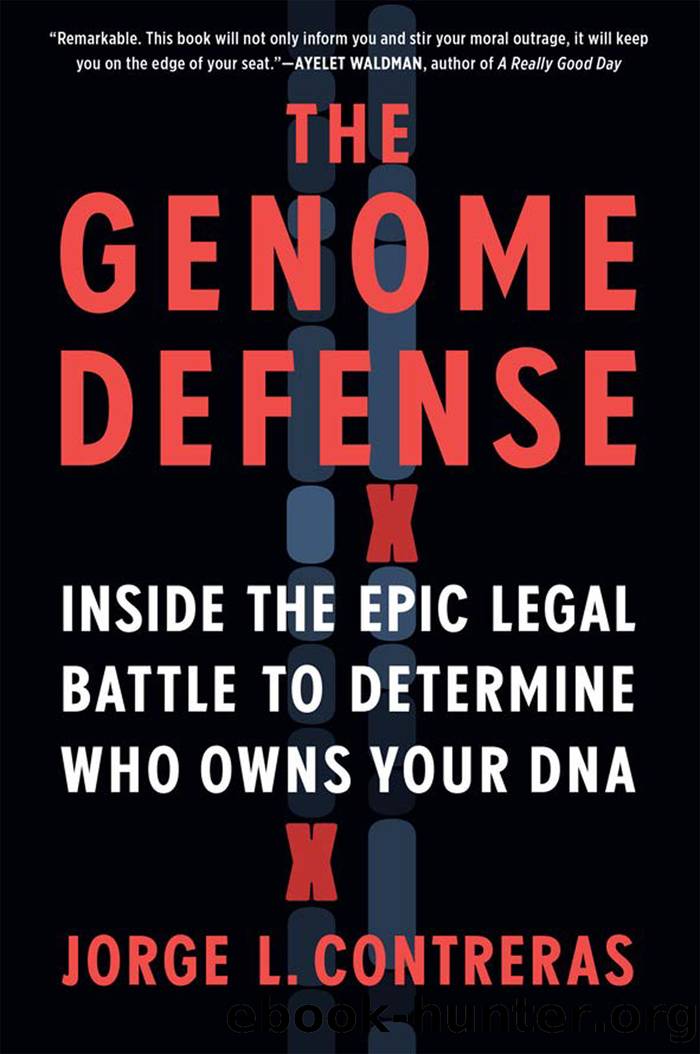The Genome Defense: Inside the Epic Legal Battle to Determine Who Owns Your DNA by Jorge L. Contreras

Author:Jorge L. Contreras [Contreras, Jorge L.]
Language: eng
Format: epub
Tags: law, Science & Technology, science, Life Sciences, Genetics & Genomics, Technology & Engineering, Biomedical
ISBN: 9781643752150
Google: ErUdEAAAQBAJ
Publisher: Algonquin Books
Published: 2021-10-26T23:35:54.201442+00:00
Shooting at the King
Coupled with Raderâs comments at Fordham, the BIO speech made it clear to Ravicher that Judge Raderânow Chief Judge Raderâdid not think much of the district court opinion in Myriad. In fact, it seemed that he had already made up his mind that Judge Sweet was wrong. Which was a problem, given that the case was being appealed to the court over which Rader now presided.
Chris Hansen agreed. There were rules of judicial conduct that couldnât be ignored. Judges werenât supposed to decide cases until the parties had submitted their briefs and argued their positions. If a judge pre-decided a case, he was clearly biased. And federal law required that a judge must disqualify himself âin any proceeding in which his impartiality might reasonably be questioned.â This seemed like such a case.
So Hansen and Ravicher filed a motion with the Federal Circuit seeking to have Chief Judge Rader recused from any involvement in their case. The move was a risky one, as it was not yet known which of the twelve circuit judges would be assigned to the three-person panel that would hear the case. Those assignments were random, and not revealed until the morning of the oral arguments. But by then it would be too late, so they had to oppose Judge Raderâs involvement now, before the panels were assigned.
Ravicher and Hansenâs motion argued that âChief Judge Raderâs statements in this case have created an appearance of partiality that calls into question his ability to engage in impartial legal analysis based on the record and the argument of the parties.â They also accused him of violating the Code of Conduct for United States Judges, which states that âA judge should avoid public comment on the merits of a pending or impending action.â These were fighting words. They called into question Raderâs judicial impartiality, the very core of a judgeâs reputation. On the battlefield of litigation, this was a nuclear option.
Castanias was puzzled and surprised by the unorthodox motion. Such tactics were direct challenges to judicial discretionâbad practice for someone who regularly appears before the court. In his brief opposing the motion, he argued that Raderâs comments at Fordham and BIO were general opinions about the state of the law, not specific opinions on the case. Nothing that Rader said at either conference implied that he had pre-judged the case, which was about DNA, not bottled water. The Federal Circuit Bar Association also weighed in against the recusal motion. They were concerned that such a motion could discourage judges from participating in public conferences like Fordham and BIOâa development that would hurt both the judiciary and the bar (and conference organizers like themselves).
Rader, privately seething, did not publicly comment on the recusal motion.
Yet the Federal Circuit never ruled on the motion. The court docket simply noted that the panel for the case had not yet been assigned, and that if Chief Judge Rader were on it, the motion would be then considered.
Castanias was not surprised. At Jones Day they had a sayingââIf you are going to shoot at the king, you had best kill him.
Download
This site does not store any files on its server. We only index and link to content provided by other sites. Please contact the content providers to delete copyright contents if any and email us, we'll remove relevant links or contents immediately.
| Automotive | Engineering |
| Transportation |
Urban Outlaw by Magnus Walker(2950)
Never by Ken Follett(2880)
OPNsense Beginner to Professional by Julio Cesar Bueno de Camargo(2802)
Sapiens and Homo Deus by Yuval Noah Harari(2414)
Machine Learning at Scale with H2O by Gregory Keys | David Whiting(2291)
A Short History of Nearly Everything by Bryson Bill(2135)
Will by Will Smith(2041)
Hooked: A Dark, Contemporary Romance (Never After Series) by Emily McIntire(1959)
Borders by unknow(1785)
Rationality by Steven Pinker(1765)
Holy Bible (NIV) by Zondervan(1716)
Freedom by Sonny Barger(1485)
The One Percenter Encyclopedia by Bill Hayes(1463)
Five Ways to Fall by K.A. Tucker(1396)
Girls Auto Clinic Glove Box Guide by Patrice Banks(1362)
Far and Near by Neil Peart(1356)
The Becoming by Nora Roberts(1330)
Cuba's Car Culture by Tom Cotter(1325)
A Short History of War by Jeremy Black(1300)
